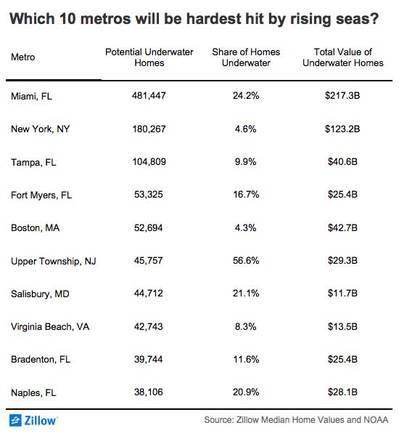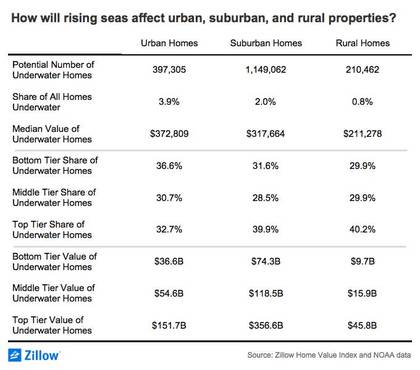The WPJ
THE WORLD PROPERTY JOURNALReal Estate Facts Not Fiction
Residential Real Estate News

Almost $1 Trillion of American Homes at Risk From Rising Seas This Century
Residential News » Miami Edition | By Michael Gerrity | October 19, 2017 9:00 AM ET
Miami has most risk exposure in U.S., followed by New York City
According to new research by Zillow, rising sea levels are expected to impact $916 billion worth of U.S homes in the next 100 years, most of which are low-end or median-value homes.
 The majority of all homes at risk of flooding due to rising sea levels are in suburban areas - 65.4 percent of homes are in suburban areas, compared to 22.6 percent in urban locations and 12 percent in rural areas.
The majority of all homes at risk of flooding due to rising sea levels are in suburban areas - 65.4 percent of homes are in suburban areas, compared to 22.6 percent in urban locations and 12 percent in rural areas.Overall, 39 percent of the homes expected to be underwater in 2100 are among the nation's most valuable. The rest are near the median value or below - and a quarter are among the least valuable homes. This is significant because less wealthy communities and households are less likely to be able to afford preventative measures to ward off rising seas. For most homeowners, a home is their biggest single investment, and its value is a major share of their overall wealth. Any significant damage to a home is harder to recover from when most of an owner's wealth is tied up in that same home.
 Owners of high-end homes are more likely to live in communities with the resources and connections needed to protect their homes, such as building sea walls or making structural changes that help homes withstand floodwaters. But in markets where the majority of homes at risk of rising water are among the least valuable in the area, these options might be out of reach.
Owners of high-end homes are more likely to live in communities with the resources and connections needed to protect their homes, such as building sea walls or making structural changes that help homes withstand floodwaters. But in markets where the majority of homes at risk of rising water are among the least valuable in the area, these options might be out of reach.Less than 20 percent of homes in Honolulu that are at risk of flooding due to rising sea levels are high-end homes. That means the majority of homeowners who could lose their homes may be less able to make investments to protect their properties, especially lower income homeowners who have to spend a larger share of their income on mortgage payments.
"We've seen the enormous impact flooding can have on a city and its residents," said Zillow Chief Economist Dr. Svenja Gudell. "It's harder for us to think about it on a long-term timeline, but the real risks that come with rising sea levels should not be ignored until it's too late to address them. With organized and committed planning, cities can help protect both current and future residents. Living near the water is incredibly appealing for people around the country, but it also comes with additional considerations for buyers and homeowners. Homes in low-lying areas are also more susceptible to storm flooding and these risks could be realized on a much shorter timeline as we have seen time and time again."
Miami holds 25.8 percent of all U.S. homes at risk of rising sea levels, which are cumulatively worth $217.3 billion. The three cities with the greatest number of homes threatened by higher sea levels are in the Miami metropolitan area. Fort Lauderdale, Miami Beach and Miami could all lose more than 30,000 homes to sea level increases.
Zillow analyzed the types of homes that could be underwater, absent preventative measures, based on recent estimates of how high sea levels could rise by 2100 due to climate change.
Sign Up Free | The WPJ Weekly Newsletter
Relevant real estate news.
Actionable market intelligence.
Right to your inbox every week.
Real Estate Listings Showcase
Related News Stories
Residential Real Estate Headlines
- U.S. New-Home Sales Surge in August as Mortgage Rates Ease
- Despite Increased Foreign Buyer Activity, Miami Residential Sales Dip 11 Percent in August
- California Home Sales Enjoy Modest Uptick as Mortgage Rates Ease
- U.S. Home-Flipping Profits Sink to Lowest Level Since 2008 Financial Crisis as Costs Climb
- Why the World's Rich Are Flocking to Europe in 2025
- Federal Reserve Delivers First Rate Cut of 2025 as Mortgage Relief Proves Limited
- Homebuilder Sentiment Holds Steady in U.S. as Rate-Cut Bets Lift Outlook
- U.S. Mortgage Rates Experience Sharpest Weekly Drop in Over a Year
- U.S. Foreclosures Rise for Sixth Straight Month as Affordability Pressures Mount
- Black U.S. Homeownership Rate Falls to Two-Year Low as Job Losses Mount
- Las Vegas Home Prices Flatten as Listings Surge, Sales Slow
- Cooling Miami Housing Market Sees 16 Percent Annual Sales Drop in July
- U.S. Mortgage Delinquencies Uptick in June Amid Regional Pressures
- California, Florida Top U.S. Housing Markets Most at Risk of Downturn
- 30-Year Mortgage Drops to 6.56 Percent in Late August, Lowest Since October 2024
- Investors Maintain Elevated Role in U.S. Housing Market Despite Slight Pullback
- Pending Home Sales Show Mixed Signals as U.S. Buyers Remain Cautious
- Canadian Home Sales Extend Recovery in July
- U.S. Home Sales Rise in July as Buyers Gain More Bargaining Power
- Zombie Foreclosures Edge Up Across U.S.
- 2.6 Million Homes at Wildfire Risk Across 14 Western States in 2025
- One in Five Americans Willing to Trade Personal Safety for Home Affordability
- U.S. Home Price Growth Slows as Affordability Pressures Mount in 2025
- U.S. Mortgage Rates Dip to Four Month Low in Early August
- U.S. Mortgage Applications Rise in Late July, Breaking Four-Week Slump
- Hong Kong's Housing Market Stuck in Stalemate as Bulls and Bears Face Off
- U.S. Condo Market Struggles in 2025
- U.S. Pending Home Sales Remain Sluggish in June
- Los Angeles Area Wildfires Destroyed Nearly $52 Billion in Homes Last January
- Greater Palm Beach Area Residential Sales Slip in June Amid Growing Inventory
- Economic Resilience Lifts U.S. Housing Outlook Going Forward
- New Home Sales Stagnate as Affordability Struggles Continue in America
- U.S. Housing Market Slips in June as Prices Hit New Highs
- Florida, California Continue to Reign Supreme as America's Ultraluxury Housing Markets
- Caribbean Housing Market Evolves into Global Second-Home Hotspot
- U.S. Home Sales See Highest June Cancellation Rate on Record
- Orlando Housing Market Cools in June as Listings Slide, Sales Slow
- Private Credit Surges in 2025 as Real Estate Developers Bypass Banks
- U.S. Condo Market Suffers Sharpest Price Drops in Over a Decade as Buyers Retreat
- Rising Taxes, Insurance Costs Undermine the Stability of U.S. Homeownership
Reader Poll
Marketplace Links
This website uses cookies to improve user experience. By using our website you consent in accordance with our Cookie Policy. Read More







